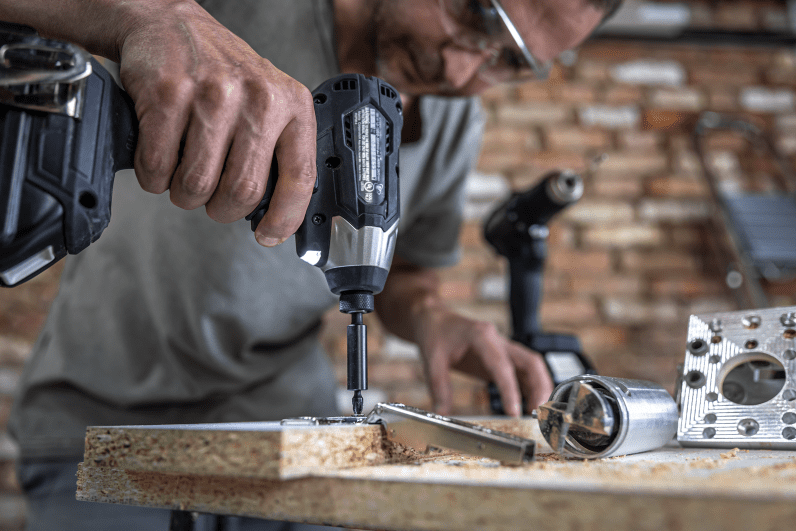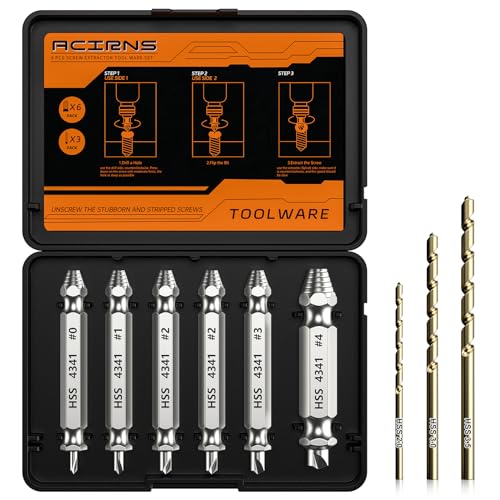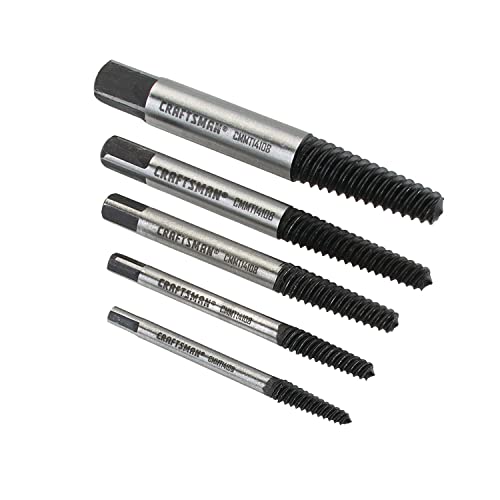The common causes of stripped screws
Stripped screws are the bane of the screwdriver-wielding mechanic’s existence. They’re usually the result of improper installation or over-tightening, but there are other causes too.
Corrosion (from water damage), rust, and wear from everyday use (i.e., turning bolts) are the most common. If you’re ever faced with a stripped screw, the first step is determining the cause.
Next, try to repair it using the following steps: gently pry off the old screw with a pick or Allen key; apply clamps around the circumference of the head of the screw to hold while you unscrew using a ratchet or wrench; replace the Screw as needed.
If the stripped screw is beyond repair, consult an expert. In the meantime, you can easily use this guide to remove stripped screws!
These are the procedures recommended for removing a stripped screw.
1. The method recommended by experts: Invest in a screw extractor
If none of the do-it-yourself methods below work, professional contractors remove stripped screws using screw extractor sets. If your screw is stripped, you must purchase a screw extractor.
This is a tool that can be found at most hardware stores. To use the screw extractor, first drill a hole into the center of the stripped screw using a drill bit that is the same size as the extractor.
Next, insert the extractor into the hole-stripped screw and turn it counterclockwise. The extractor will grab onto the screw and allow you to remove it.
Be sure to purchase the correct size of screw extractor for your stripped screw. For any questions, please get in touch with the sales staff at your local hardware store for assistance.
2. Make use of ScrewGrab
ScrewGrab is a gel that increases friction when applied to a stripped screw head. Professionals keep a bottle in their toolbox because it is frequently helpful.
Add drops to the screw opening to aid the screwdriver’s grip. This is also an excellent method for small, delicate screws like those on a computer or phone.
3. Using a hammer, tap the screwdriver
One of the simplest ways to repair a stripped screw is to tap the screwdriver lightly into the screw with a hammer.
This will allow you to seat the tool deeply enough to remove the stripped screw. Pros recommend beginning with a very gentle tap on the screwdriver’s butt.
4. Make use of a rubber band
A rubber band may be used to remove a stripped screw. Place a rubber band the width of the screw head over it, then use a screwdriver or drill driver on top of it. The rubber may fill in voids and provide additional grip for the tool.
According to Professionals, a similar handyman trick involves using steel wool in the same manner. Due to the widespread availability of rubber bands and steel wool, this may be the simplest solution for a stripped screw.
5. Experiment with a larger driver bit
If you’re using a drill with a driver bit, try using one larger than the screw head you’re working on.
Occasionally, the larger bit distributes the force more evenly, providing you with additional leverage to remove the stripped screw.
6. Experiment with various screwdrivers
According to Pros, if the drill driver does not work, try using a manual screwdriver; drills occasionally have too much torque and can further strip the screw.
Using a variety of different-sized screwdrivers may provide you with the necessary grip.
Consider one with a different tip or blade size. Remove a stripped Phillips-head screw with a small flat-head screwdriver.
To be prepared, Pros recommends stocking your toolbox with various screwdrivers of varying sizes and types. Additionally, use a brand-new screwdriver, as the issue could be with a worn tip or blade.
7. Try using pliers with a locking mechanism
If any exposed portion of the screw or screw head is visible, you may be able to remove it with locking pliers.
Wrap the pliers tightly and securely around the stripped screw head, then twist them counterclockwise to remove them manually.
If the screw is too deep in the wood for pliers to grip, use a flat-head screwdriver to push the wood down around the screw to aid in gripping.
8. Create a brand-new slot
If you have a rotary cutter or a small hacksaw, you can cut a slot across the screw head to accommodate a flat-head screwdriver.
Though Professionals caution that this method is risky and can easily damage the surrounding material, they advise using it as a last resort.
Bonus Methods
Use a left-handed drill bit
Regular screws can be loosened by rotating to the left. The flutes on the less popular left-handed drill bit rotate counterclockwise.
To release a stripped screw, a left-handed drill bit may provide greater torque than a right-handed bit. But the drill has to be in reverse for it to work.
Try the hot glue gun
Instead of rushing out to get a new tool to remove stripped screws, use your glue gun, which you most likely already have at home. While the glue cools and dries, insert your screwdriver into the glue-filled screw head. The stripped screw can be removed simply by carefully turning it with a screwdriver.
Cut the screw head in with an oscillating tool.
Attach the metal-cutting disc and make a new, deeper slot in the stripped screw if you have an oscillating tool, such as a Dremel, in your workshop. Continue by inserting a flathead screwdriver firmly into the ding and slowly rotating it, of course, the flathead screwdriver should fit snugly.
The takeaway from an insider
Stripped screws are a common occurrence when performing home improvements. Several do-it-yourself solutions include hammering the screwdriver deeper into the stripped screw head, using a rubber band for added grip, or twisting the screw out with locking pliers.
Professionals recommend using a friction-increasing gel such as ScrewGrab or a screw extractor drill bit to remove stubborn screws.
FAQ
Q: What is a stripped screw?
A: A stripped screw is a screw with damaged or worn-out threads that can no longer grip the surrounding material, making it difficult to remove.
Q: How do I remove a stripped screw?
A: There are several methods you can use to remove a stripped screw, including using a rubber band, abrasive powder, or a screw extractor kit.
Q: What is a screw extractor kit?
A: A screw extractor kit is a set of tools designed to remove stripped screws. It typically includes extractor bits, drill bits, and other tools for creating a pilot hole and extracting the screw.
Q: Can I use pliers to remove a stripped screw?
A: Using locking pliers or vice grips to grip and turn a stripped screw. However, this method can be less precise and more complex than a screw extractor kit.
Q: Can I use an electric drill to remove a stripped screw?
A: You can use an electric drill or an impact driver to remove a stripped screw. However, use the right size and type of bit to avoid damaging the screw or the surrounding material.
Q: What is the rubber band trick for removing a stripped screw?
A: The rubber band trick involves placing a rubber band over the stripped screw’s head and pressing down firmly with a screwdriver or drill bit. The rubber band fills in the gaps between the tool and the screw, giving you more traction to turn the screw.
Q: What is the steel wool method for removing a stripped screw?
A: The steel wool method involves sprinkling a small amount of abrasive powder onto the stripped screw’s head and pressing it firmly with a screwdriver or drill bit. The abrasive powder creates friction between the tool and the screw, giving you more grip.
Q: What should I do if I can’t remove a stripped screw?
A: If you can’t remove a stripped screw with the above methods, you may need professional help or consider other options, such as drilling the screw or using a screw extractor tool.
Q: How can I prevent screws from becoming stripped in the first place?
A: To prevent screws from becoming stripped, use the right size and type of screwdriver or drill bit, avoid overtightening screws, and use lubricants or thread-locking compounds when appropriate.
Q: Can I fix a stripped screw hole?
A: Yes, you can fix a stripped screw hole using several methods, such as filling it with wood filler or toothpicks and glue or using a screw anchor or a larger screw to create a new thread.
Q: What should I do if a screw breaks off in the material?
A: If a screw breaks off in the material, you can try using a screw extractor kit or drilling a small hole beside the broken screw and using a pair of pliers or a nut to loosen it.
Q: What is the most reliable method for removing a stripped screw?
A: The most reliable method for removing a stripped screw is using a screw extractor kit. It gives you more grip, control, and precision when extracting the screw and is a reliable method for getting the job done.
Q: Can I use the same screw after it’s been extracted?
A: It depends on the condition of the screw after it’s been extracted. If the threads are damaged or worn out, replacing the screw with a new one is best.
Q: What kind of screws are most prone to becoming stripped?
A: Screws made of soft metal or plastic are more prone to becoming stripped than those made of more rigid materials like steel or titanium.
Q: What should I do if I strip a small screw?
A: If you strip a small screw, you can use a smaller screwdriver or drill bit that fits more snugly in the screw’s head or a rubber band or abrasive powder to get a better grip.
Q: Can I prevent stripped screws with a different driving technique?
A: Yes, using a different driving technique, such as applying firm pressure and turning slowly, can help prevent stripped screws. It’s also important to use the right size and type of screwdriver or drill bit for the job.
Q: Can I reuse a stripped screw hole?
A: It depends on the severity of the stripping. If the hole is only slightly stripped, you may be able to reuse it with a larger screw or a screw anchor. However, if the hole is severely stripped, creating a new one is best.
Q: Is there a way to fix a stripped screw in metal?
A: Yes, you can fix a stripped screw in metal using a tap and die set to create a new thread or a thread repair insert.
Q: Can I use the rubber band trick for large screws?
A: The rubber band trick may not work as well for larger screws, as the rubber band may not provide enough grip. In this case, you may want to try using a screw extractor kit.
Q: Can I use the steel wool method on delicate surfaces?
A: The steel wool method can scratch or damage delicate surfaces. It’s best to avoid using abrasive powder on soft materials and use a different method, such as a rubber band or a screw extractor kit.
Q: Can I use a screw extractor kit on a crooked screw?
A: It may be more difficult to use a screw extractor kit on a crooked screw, as the extractor bit may slip or break. In this case, you may need to try other methods, such as drilling a small hole beside the screw and using pliers or a nut to loosen it.
Q: How can I prevent stripped screws in the future?
A: To prevent stripped screws in the future, use the right size and type of screwdriver or drill bit, avoid overtightening screws, and use lubricants or thread-locking compounds when appropriate. You can also use a screw starter or a pilot hole drill bit to create a small hole before inserting the screw.
Q: Are there different types of screw extractor kits?
A: There are different types of screw extractor kits, such as spiral flute extractors, straight-fluted extractors, and multi-flute extractors. The type of kit you use will depend on the size and location of the stripped screw.
Q: Where can I buy a screw extractor kit?
A: Screw extractor kits are available at most hardware stores, home improvement stores, and online retailers. Be sure to choose a kit appropriate for the size and type of screws you’re working with.
TIP
When working in your garage, a ceramic heater is an excellent option for heating a garage during the winter because it is portable, efficient, and safe.
It can be easily moved around the space to provide targeted heat where needed, and it has a ceramic element that heats up quickly and maintains a consistent temperature.
Additionally, ceramic heaters often have safety features such as overheat protection and tip-over switches to prevent accidents.
Overall, a ceramic heater is a convenient and effective way to keep a garage warm during winter.
Conclusion
Finally, dealing with stripped screws can be a frustrating experience, but with the right tools and techniques, you can easily remove them and fix the problem.
Using a screw extractor kit is one of the most reliable methods for removing stripped screws, but you can also use other tricks and methods depending on the circumstances.
Remember to take your time, be patient, and use the right tools to avoid damaging the surrounding material or worsening the problem.
You can check the best ceramic heaters in our next article:
Efficient Heating: The Best Ceramic Heaters of 2023
Last update on 2024-11-21 / Affiliate links / Images from Amazon Product Advertising API




































